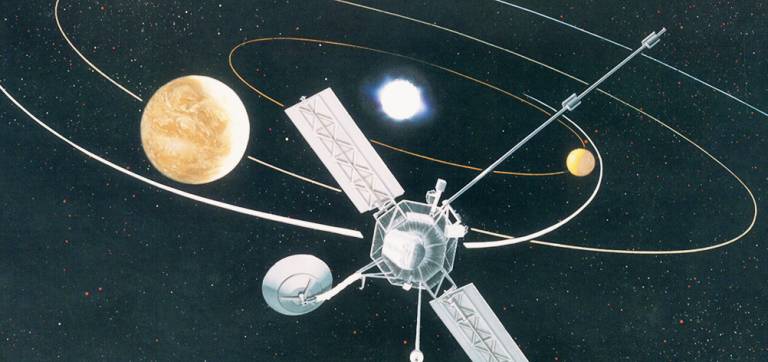Magnetic Rope observed for the first time between Saturn and the Sun
6 July 2016
![An artistic illustration of an FTE at Saturn’s magnetopause. The background colors are contours of plasma density from the global MHD model of Jia et al. [2012] to show the global configuration of Saturn’s magnetosphere. An artistic illustration of an FTE at Saturn’s magnetopause. The background colors are contours of plasma density from the global MHD model of Jia et al. [2012] to show the global configuration of Saturn’s magnetosphere.](https://www.ucl.ac.uk/mathematical-physical-sciences/sites/mathematical_physical_sciences/files/styles/large_image/public/Saturn_3D_final6_16.jpg?itok=u_TtaAnD)
A twisted
magnetic field structure, previously never seen before at Saturn, has
now been detected for the first time, using instrumentation built at UCL
and Imperial College.
When the Sun's magnetic field interacts
with the Earth's magnetic field (the magnetosphere), a complex process
occurs called magnetic reconnection which can twist the field into a
helical shape.
These
twisted helically structured magnetic fields are called flux ropes or
"flux transfer events" (FTEs) and are observed at Earth and even more
commonly at Mercury. The conditions that allow FTEs to be generated at a
planet worsen with distance from the Sun, however they have been
observed at all the planets out to Jupiter.
The observation of
this phenomenon at Saturn has been elusive. Searches have been
undertaken to find an FTE with NASA's Cassini spacecraft, with reports
published of none being found. Up until now….
The Cassini
spacecraft has been in orbit around Saturn since 2004, and after many
years analyzing the data collected, Cassini has observed the first FTE
at Saturn. The observed magnetic signature was successfully compared to
that of a model to show that Cassini indeed observed a flux rope at this
giant magnetosphere, and that the spacecraft passed close to the
structure's center. It is also estimated that the flux rope could be up
to 8300 kilometers wide.
"Contrary to previous ideas about
Saturn's magnetosphere being unlike
its terrestrial counterpart, these findings reveal that Saturn at times
behaves and interacts with the Sun in much the same way as Earth." Jamie
Jasinski, UCL Space and Climate Physics PhD graduate now based at the
University of Michigan, and lead author of the new paper published in
Geophysical Research Letters.
This not only shows that magnetic reconnection occurs at
Saturn but also that Saturn's magnetic field can at times interact with
the Sun in much the same way as at Earth.
The analysis was
completed using a particle spectrometer built at UCL and a magnetometer
built at Imperial College, both of which are onboard NASA's Cassini
spacecraft.
The Cassini mission will end in November 2017, when
the spacecraft will be steered into the planet to study it, before
disintegrating in Saturn's thick atmosphere.
 Close
Close




